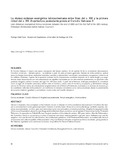La domus ecclesiae evangélica latinoamericana entre fines del s. XIX y la primera mitad del s. XX Arquitectura protestante previa al Concilio Vaticano II

Ver/
Use este enlace para citar
http://hdl.handle.net/2183/23071
A non ser que se indique outra cousa, a licenza do ítem descríbese como Atribución-NoComercial 4.0 España
Coleccións
Metadatos
Mostrar o rexistro completo do ítemTítulo
La domus ecclesiae evangélica latinoamericana entre fines del s. XIX y la primera mitad del s. XX Arquitectura protestante previa al Concilio Vaticano IITítulo(s) alternativo(s)
Latin American evangelical domus ecclesiae between the end of XIXth and the first half of the XXth century. Protestant Architecture before Vatican Council IIAutor(es)
Data
2015Cita bibliográfica
Vidal Rojas, R. (2017). La domus ecclesiae evangélica latinoamericana entre fines del s. XIX y la primera mitad del s. XX. Actas De Arquitectura Religiosa Contemporánea, 4, 68-77. https://doi.org/10.17979/aarc.2015.4.0.5121
Resumo
[Resumen] El Concilio Vaticano II inspiró una nueva concepción del templo católico. En el capítulo VII de la constitución Sacrosanctum Concilium, el templo —llamado iglesia— se entiende a partir de siete principios generales: libertad de estilos artísticos; aptitud para una liturgia comunitaria; capacidad simbólica; sencillez y autenticidad; comodidad; casa abierta y acogedora; y reforma de los edificios existentes. A pesar de la aparente novedad de las inspiraciones conciliares respecto de la nueva liturgia y su arquitectura, estas disposiciones son una actualización de aquellas impulsadas por los reformadores protestantes, en oposición a las prácticas litúrgicas católico-romanas del siglo XVI, 400 años antes. A partir de la Reforma, el templo protestante es concebido como el lugar de encuentro personal y directo entre el hombre y Jesús; entre el hombre y su prójimo; y del hombre consigo mismo. En América Latina, las orientaciones arquitectónicas de la Reforma Protestante, asociadas a la carencia de recursos y a las cualidades culturales de la población, se manifiestan en templos concebidos como domus ecclesiae, dando la preeminencia al encuentro fraterno, igualitario y comunitario, mucho antes del Concilio Vaticano II. [Abstract] Vatican II inspired a new conception of the Catholic church. In chapter VII of the constitution Sacrosanctum Concilium, the temple
is conceived from seven general principles: freedom of artistic styles; fitness for a community liturgy; symbolic capacity; simplicity
and authenticity; comfort; open and welcoming home; and renovations of existing buildings. Despite the apparent novelty
of the council inspirations about the new liturgy and architecture, these provisions are an update of those driven by the Protestant
Reformers, in opposition to Catholic-Roman liturgical practices of the sixteenth century, 400 years before. After the Reformation,
the Protestant church is conceived as a place of personal and direct meeting between man and Jesus; between man and his neighbor; and man himself. In Latin America, the architectural guidelines of the Protestant Reformation, associated with the lack
of resources and cultural qualities of the population, they manifested in temples conceived as domus ecclesiae, giving priority to the fraternal, egalitarian and communal encounter, long before the Second Vatican Council.
Palabras chave
Domus ecclesiae
Concilio Vaticano II
Arquitectura protestante
Templo evangélico
América Latina
Vatican Council II
Protestant architecture
Evangelical church
Latin America
Concilio Vaticano II
Arquitectura protestante
Templo evangélico
América Latina
Vatican Council II
Protestant architecture
Evangelical church
Latin America
Versión do editor
Dereitos
Atribución-NoComercial 4.0 España
ISSN
2340-5503






